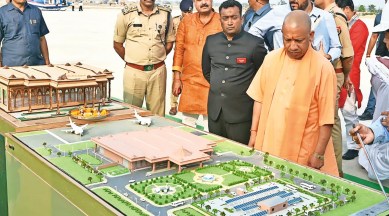Stay updated with the latest - Click here to follow us on Instagram
Govt embarks on mission to turn Ayodhya, capital of ‘Surya Vansh’, into first solar city of state
Taking the mission forward, the Uttar Pradesh New and Renewable Energy Department (UPNEDA) has undertaken an extensive plan to make Ayodhya one of its kind “solar city”, The Indian Express has learnt.

As Chief Minister Yogi Adityanath promised to restore the historical glory of Ayodhya and turning the capital of Surya Vansh (the dynasty Lord Ram belonged to) into the state’s first “solar city”, his government has undertaken several infrastructure development projects to turn Ayodhya into an “ideal city” by the time the Ram Temple construction ends — by year-end.
Taking the mission forward, the Uttar Pradesh New and Renewable Energy Department (UPNEDA) has undertaken an extensive plan to make Ayodhya one of its kind “solar city”, The Indian Express has learnt.
monthly limit of free stories.
with an Express account.
“Surya Vansha ki Rajdhani hai to yahan par sari bijli kahin aur se nahi balki renewable energy solar power ke upyog se hoga (Ayodhya is the capital of Surya Vansh, so here electricity will come not from other sources but from renewable solar energy),” Adityanath had on May 4 declared in Ayodhya as his government has already been working at a fast pace to turn it into a reality.
With an estimated expenditure of Rs 40 crore, the project aims to illuminate heritage sites, over 80 government buildings, schools, a section of public transport, purified drinking water kiosks, shops in vending zones, especially surrounding Parikrama Marga, boats on the Saryu river and nearly 10,000 households, said officials. Among other things, the project will have a solar power kitchen for 10,000 people, solar power-based purified drinking water kiosks with 5,000 litres on the lines of Konark’s Sun Temple in Odisha and a 100 MW solar plant on the banks of Saryu coming in phased-manner.
The aim is to make available basic amenities, besides the beautification of the city, across Ayodhya, especially at Parikrama Marg, using solar power by the time the temple is opened to the public, said officials.
Assisting tourists visiting Ayodhya, the city will also have ‘solar trees’ at tourist places, parks, bus stands, railway station, etc, with sitting facilities and charging points for mobiles and laptops. These solar trees will have solar panels in branch-like structures with LED lights.
Though the solar city project is a five-year plan (2023-28), amenities like streetlights, solar panels at government buildings, solar trees, e-rikshaws with charging stations and solar energy-powered purified drinking water kiosks will be covered in the first phase to provide a significant infrastructure push by the next year when the temple opens, said officials.
Out of a targeted installation of 500 solar streetlights, 456 have already been installed across the city, including at Parikrama Marga, besides 100 solar high masts. Similarly, out of the total 2MW targeted power generation from solar panels installed on government buildings, solar panels with a capacity to generate 1.5 MW has already been installed — 155kW capacity solar panel at AND Agriculture University, 250 kW at RML Awadh University, about 100 kW at District Court Ayodhya, about 58 kW at Ram Katha Museum and about 50 kW at different government secondary schools.
Further, 30 kW capacity of solar panels has been installed at the Commissioner’s office, about 50 kW at Municipal Corporation buildings, about 65 kW at the Fisheries Department building, and 25 kW each at the District Transport office and Government Polytechnic in Ayodhya. The tendering process for the purchase of solar boats is also in progress.
“Ayodhya is the first solar city project in the state. Our target is to encourage 10,000 households to go for the rooftop solar panels. For creating awareness about the incentive, camps are being organised in each ward of Ayodhya. We have so far achieved about 300kW of domestic solar installations,” said UPNEDA Director Anupam Shukla.
Asked how they are encouraging households to go for solar power, Shukla said incentives from both the Centre and the state government cover up to 40 per cent of the installation cost. “In addition, individual units have been connected with the regular grid, which also helps them reduce their electricity bills drastically as additional energy generated is transferred to the grid and is compensated for the nighttime usage. For up to 2kW installation, about Rs 15,000 subsidy is being provided by the central government and up to Rs 30,000 by the state government under its Solar Energy Policy 2022,” he said.
Notably, as per the 2022 Solar Policy, any city where 10 per cent of electricity demand is met through renewable energy will be referred to as a solar city.
Though Ayodhya will be the first such city in the state, the government has set a target to go beyond the 10 per cent benchmark.
The plan also includes a 100 MW solar plant on the banks of the Saryu.
The first phase has been broadly divided into six parts, which includes solar trees with integrated seating, e-rikshaws with solar charging stations, solar power-based drinking water kiosks, solar high masks for public lighting, solar-powered lighting system and solar projects for vending zones.
To meet the target, said sources, the process for the purchase and installation of 40 solar trees, 40 e-rikshaw and eight e-rikshaw charging stations, 40 solar-based drinking water kiosks, 50 kW off-grid solar plant for vending zone has already been started.